Artists at Work: Etienne de France
by Anna Milone
Looking for the Perfect Landscape by Etienne de France on Vimeo.
From a questioning of landscape as a space of imagination and emancipation, French artist Etienne de France elaborates a fictional but highly credible series of narrative works which are always set in determined landscapes, whether these are identified or not. These projects, which have recently taken him to New Zealand, Brazil, Colombia, and Chile, are an invitation both to travel and to question our own environment. His new video artwork, Looking for the perfect landscape (2017), grounded in Mohave culture and shot in collaboration with the Colorado River Indian Tribe, was completed as part of a FLAX (French Los Angeles Exchange) Projects residency. The video project, its storyline and development, evolved based on encounters and meetings between de France and the diverse participants—elders, cultural practitioners, artists, activists, environmentalists, and archeologists—he involved. In this video, Jamahke, a young Mohave artist, works for the Colorado River Indian Tribe Museum in Parker, Arizona. One day, he is hired by a film production company to scout for landscape and locations for a period feature film, taking place in Mohave aboriginal territory.
The video, made in consultation with the Autry Museum of the American West, premiered on November 5 at the Echo Park Film Center in Los Angeles. The version above was created specifically for East of Borneo.
Anna Milone: Let’s start with your personal interest in Native American cultures. When and how did you become interested in their history and culture?
Etienne de France: I always had a strong interest in Native American culture and would read about it as a kid, growing up. I remember in high school, I was very interested in the conflicts happening in the Amazonia region. I held on to these events as I became an artist, focusing on the relationship we have to nature and the landscape. It’s impossible, in that context, to avoid the perspective of Native Americans—or other native cultures all around the world—because they have a very elaborate, very long and sustained relationship to the land.
When I was in Iceland, I shot my first film, Tale of a Sea Cow (2012), in which there was already a native voice, through a Greenlandic person who shared myths and legends with me and through various cultural references. I think this interest of mine has always been there, and specifically for Native American culture.
Three years ago, I started to write a script for a feature film about the question of representation of landscape in a Navajo and Hopi context. I had traveled through some of their territories, and it raised many questions for me. I wrote a detailed synopsis, carried out a lot of research, and learned about a Hopi visual artist from Arizona, Victor Masayesva Jr. I also read some very interesting books on Native American cinema and the question of the representation of the Indian in cinema, including Indian’s Song: Des Indiens d’Hollywood au cinéma des Indiens by Gilles Laprévotte and Thierry Roche. This specific project never happened but last year, you and FLAX gave me the opportunity to revisit it.
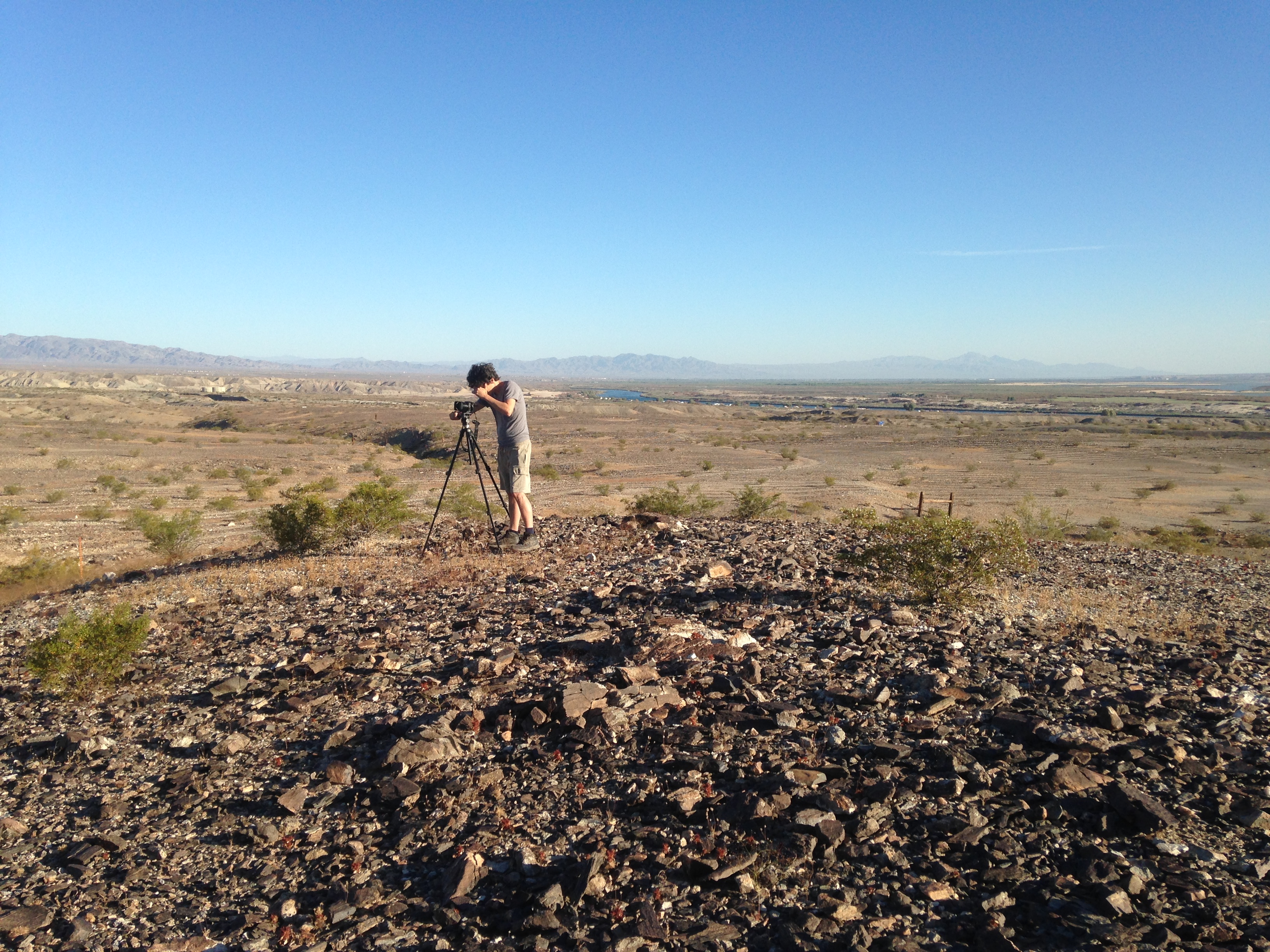
Artist Etienne de France at Topock Maze, Needles, California. All photos © Etienne de France.
AM: How did you shift from the Navajo and Hopi cultures of the original project to the Mohave culture, and why did you choose this tribe, specifically?
EDF: I started focusing on Navajo and Hopi cultures because they are very known in other countries, so it was easier to access information about them from France. I was also interested in working in Utah; that’s why, at the time, I chose to work on a story involving Hopi, Navajo, and Pueblo culture.
For Looking for the perfect landscape, I decided to focus on California where many tribes are located, all culturally unique and fascinating. I chose the furthest-east tribe of California because I wanted to work in a desert area. I wanted to confront this landscape that attracted me visually, historically, symbolically, politically.
My research on the tribes that were in the desert led me to the Mohave tribe for many reasons. First, they have an agricultural history on the banks of the Colorado River that shapes their relationship to their territory. They were also in a hub of trade routes that spanned across California, which allowed them to be in contact with many other tribes.
In the region I focused on, the Mohave people are now split into two entities. One lives in the Fort Mohave Reservation. The other is close to Parker on the Colorado River Indian Tribe (CRIT) reservation, which is a crossroads area consisting of four different tribes: the Mohave, the Chemehuevi, the Navajo, and the Hopi. Even though I didn’t work with the other tribes, I found this structure very interesting.
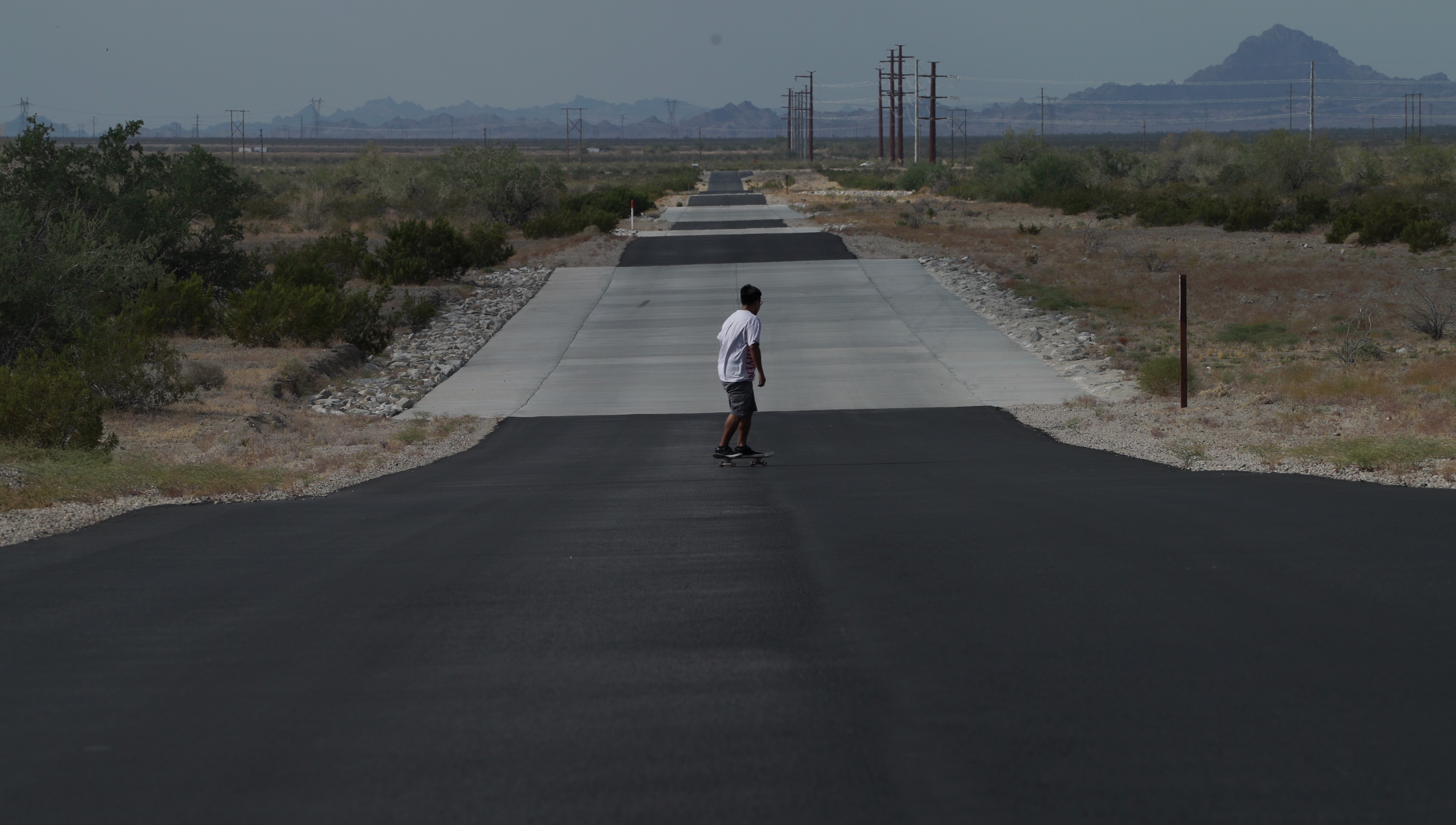
Etienne de France, Looking for the Perfect Landscape, 2017, video, color, sound, 45 min
Many aspects of their culture were fascinating to me. They have a culture connected to dreams, a strong relationship to songs and myths, and very specific funerary rituals. French psychotherapist George Devereux spent time with Mohave to study their cultures and specifically their relationships to dreams. It was an interesting bridge for us, as French people, to the Mohave culture.
Lastly, and probably what first and foremost led me there, are the environmental struggles and fights happening between the Mohave people and the energy, solar and gas companies. These struggles are happening in many places in the United States and they are extremely significant for the Mohave people.
AM: Will any of these environmental issues be addressed in your video?
EDF: I touch upon two current struggles in my video but I am not the best person to speak about these. The tribe’s spokesmen are the only ones who can really speak about it.
The first issue we addressed in the video is the McCoy Solar Project, which came after the big disaster caused by the Genesis Project, a concentrated solar power station located about 25 miles west of Blythe, in the Colorado Desert along an ancient trade route that native people had traveled for thousands of years. The route traversed the Sonoran Desert and enabled trade between the Colorado River and the coast.
Both these projects were implemented on aboriginal land which the tribe recognizes as theirs since time immemorial, but these lands are not on the current Mohave reservation as determined by the US Administration.
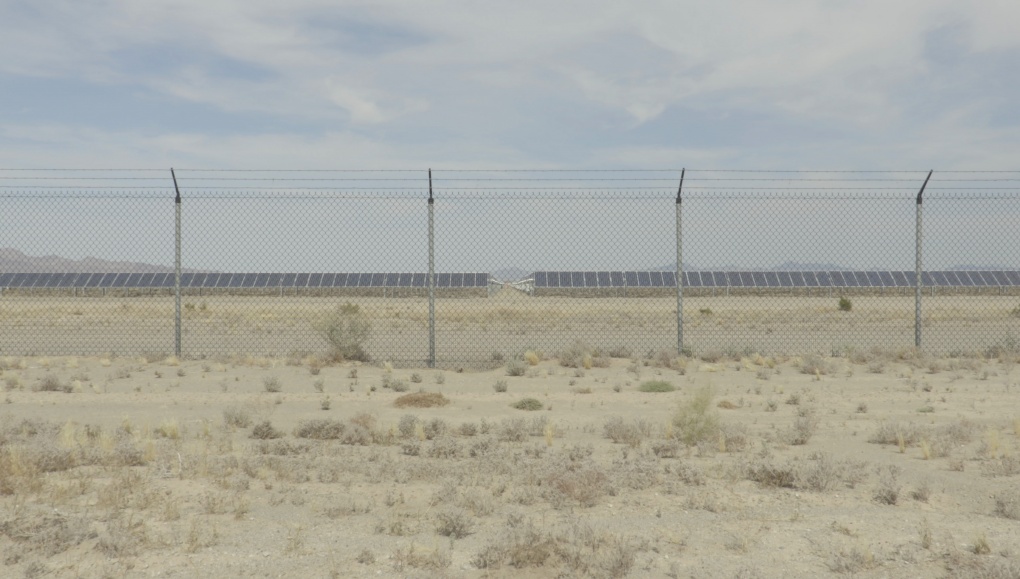
Etienne de France, Looking for the Perfect Landscape, 2017, video, color, sound, 45 min
The issue with these solar companies—green companies—is how and how fast they are implemented into an area. They are fast-tracked by governmental officials and indigenous peoples are excluded from the planning process. For the Genesis Project, the tribe was never consulted. During construction, 3,000 artifacts were excavated. Some were destroyed and others are now stored in a room at the San Bernardino Museum. People can’t access them at all. It’s a big scandal.
The damage has already been done to the land and to the artifacts that were discovered. The land is lost and the spirituality is completely damaged in that place. With the McCoy solar project that we see in the video, the re-burial protocols and discussions between industries were much better handled than they were during the Genesis solar project.
Another emblematic example is the case of Mystic Maze, a sacred place for the Mohave people. It is the spirit’s gateway: the soul crosses this area before reaching the land of the dead. This site is a very important spiritual passage for the Mohave people, both from Fort Mohave and from the Colorado River Indian tribe. First the railroad, then Route 66, the highway, the interstate traverse this site, desecrating it.
Since sometime in the ’60’s, I’m not sure about the date, Pacific Gas & Electric Company (PG&E)—the same company responsible for the groundwater contamination disaster in Hinkley, California, and in other areas of the United States—has been laying pipelines through this sacred site.
Imagine if an energy company was tunneled under Notre Dame of Paris. Think about an energy company setting up a plant and digging pipes in the Cathedral of Our Lady of the Angels in Los Angeles. It’s just as simple as that, and it explains why there have been so many lawsuits. Remediation and cleanup are ongoing, but it is still a very complicated issue.
Again, I’m just trying to say what I know of it, but the people who really know are the representatives of the tribe. They are the ones who are still fighting today in court.
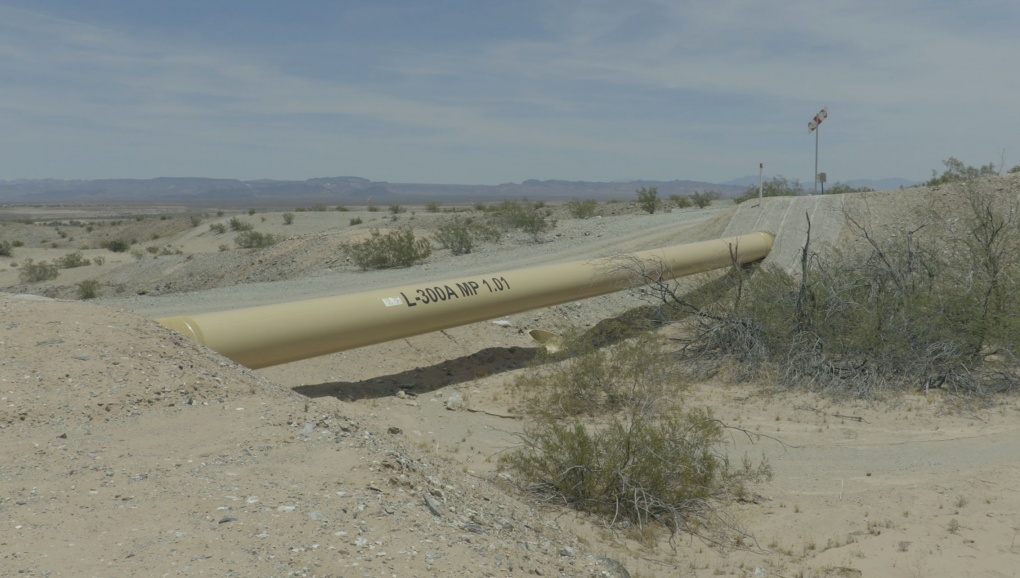
Etienne de France, Looking for the Perfect Landscape, 2017, video, color, sound, 45 min
AM: For this project, you collaborated with the representatives of the tribe, the spokesmen. Before digging into the process, I want to start with your research. We have been in discussion with the Autry Museum, which was your first stop as soon as you arrived in Los Angeles. You then met several people who were instrumental to your collaboration with the tribe. Can you walk us through this process?
EDF: First, I carried out research on my own. I gathered all the articles I could find online, especially about the solar projects and conflicts. I built an archive from various sources on the southwest states including a journal called Indian Country and a documentary series called “Tending the Wild” produced by KCET in collaboration with the Autry Museum.
The Autry Museum team [Chief Curator Amy Scott, Senior Media Producer Laura Purdy, and Gamble Assistant Curator of Western History, Pop Culture, & Firearms Josh Garret Davis] recommended many people. They connected me to historians, artists, specialists, and the cultural representatives of the tribe.
One important contact was a scholar called Philip M. Klasky from San Francisco. He’s been working with the Chemehuevi and Mohave tribes for 30 years, studying their creation songs and also fighting with them against this nuclear waste project called the Ward Valley Project; it’s located in a very important place for the Mohave, Chemehuevi, and other tribes there. He shared many documents with me.
I met a lot of people who were very generous. My project is grounded in these exchanges and the information these people sent me.
AM: How did you go from research to scouting trips?
EDF: When I arrived at Parker, I contacted the tribal council of the Colorado River Indian tribe and David Harper, who, as a spokesman for the tribe and the Chairman of the Elder Committee, was very present in the media. As a cultural representative, he takes care of all the cultural issues for the tribe.
If there is an issue with a solar company, for example, he would come and explain the point of view of the tribe and how the tribe should be consulted when there is an ongoing industrial project.
He was receptive from the first moment I called him. We went to visit him, to explain the project. I went back to see him, and he invited us to stay one week, to see the land. We went to many places together, and he introduced us to several people, including bird singers and elders.
AM: How did these trips transform your project? Who did you meet, and what did you learn that shapes the project as it is now?
EDF: I discovered many important places with David—spiritual places, and places of current conflict and local initiatives. An example at the Colorado River Indian Tribe Reservation is this place called the Preserve.
The Preserve is a natural reservation where the tribe is growing mesquite trees. These trees are used in many ways—to make cradles, clothes, food—but also as burning wood for cremation ceremonies, which are a very important foundation of their culture. These trees were disappearing, so they created the preserve. It became a place where all kinds of celebration are now held, like bird singing and weddings. It is a peaceful place, like a garden.
It is an example of conservation that combines scientific and environmental data with Mohave culture, knowledge, and ceremonies. In terms of nature conservation policies, it is a very interesting model to look at.
We visited a sacred place called Avikwame, also known as Spirit Mountain, which is considered the original land of several tribes, including the Mohave; it stretches all the way south to Mexico and north to Las Vegas. All these tribes share the same language, the same creation myths, and they all started in this amazing place with an oasis in the middle. It’s an incredible place.
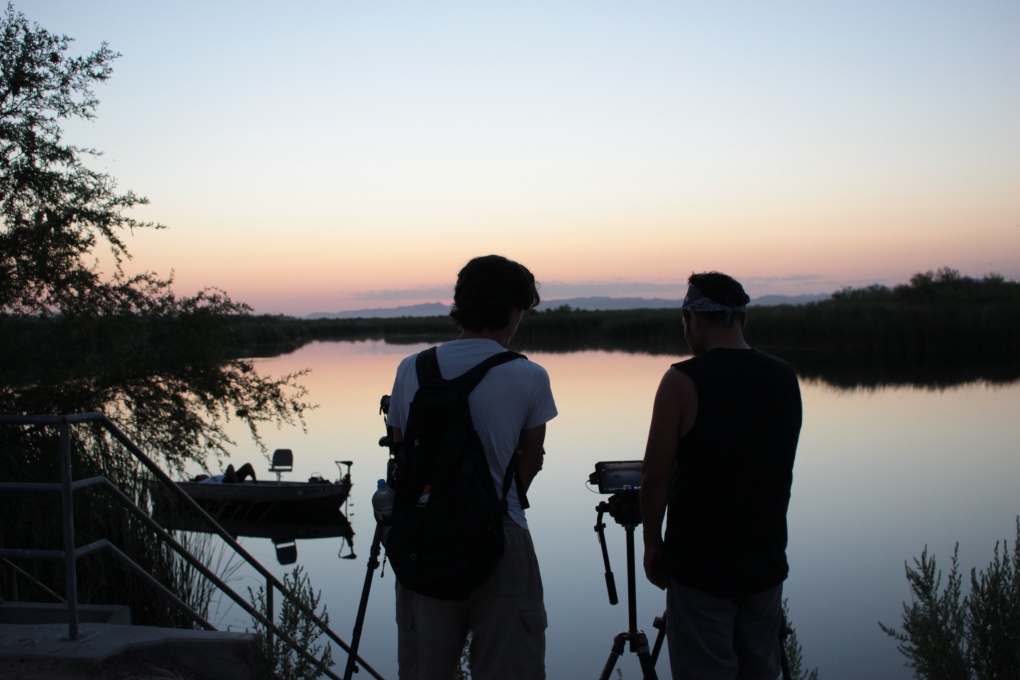
AM: You almost describe what could be perceived as an Edenic garden. Aren’t you worried about sharing a simplistic vision of an idealized natural place desacralized by colonization?
EDF: This project is not about being black-and-white, or being simplistic about these cultural contrasts. But if you think about Route 66 and how it has erased a part of history—it has completely opened up to the Californian genocide. It’s completely mad. And today this area is covered with these crazy western movies places. For me, it’s a scandal. Take this village called Highberry; it’s pathetic. You have all these tourists going to this western saloon without giving a thought to the history of the place. On Route 66, these villages are often the former trading posts, created when the United States opened up roads to the west. These places may not be directly related to Mohave spiritual places but they represent the western invasion of Mohave land.
David also introduced me to the elders. We had to go through a very important process in front of the Elder Committee. We presented the project, to get it voted on and approved. David asked for fast-tracking, because it’s usually very hard to get authorization to film on a reservation. Once the Elder Committee approved the project, David asked the Tribal Council to approve the shooting. Like in every government entity, you don’t meet everybody. Some people are for, some people are against. I don’t know if everybody opted for the project but a majority gave us the opportunity to film there. Everything happened quickly.
That week was essential in so many ways. It was an entry path, guided by David, to the many aspects of their culture.
AM: And you met your lead actor, as well, on this trip?
EDF: Yes, in a way. He’s not an actor. I don’t know how to define his role.
AM: Let’s call him the main character of the video.
EDF: Yes. So Jamahke Welsh is one of the bird singers David introduced me to. At that point in the scouting trip, I realized that I had only the point of view of David, who was taking us to these places and introducing us to people. I was missing a younger person’s perspective.
AM: Someone of your age, your generation?
EDF: Yes. I was curious. One evening, we met a bird singer in his thirties—that was Jamahke—and a lead bird singer called Larry Hammond Jr. Unfortunately, Larry could not work on the video, but his input was crucial. He introduced us to the meaning of bird singing and the creation songs which constitute spiritual maps and journeys through Mohave ancestral lands.

Etienne de France, Looking for the Perfect Landscape, 2017, video, color, sound, 45 min
When we met Jamahke, he was a bit apprehensive. He didn’t want to come and I understand completely. Why would he meet a white guy who comes to the reservation and wants to meet bird singers? What’s the point of it? But his girlfriend pushed him to come.
We met and it was a very friendly meeting. Sometimes you meet people in the process of your work and you just know there is something going on. We had a really good conversation that ended with them singing a song.
It was just amazing. At that time, he was working for the Colorado Indian River Tribe Museum. We met again and he offered me two DVDs about the songs and their history. It was so generous, and I immediately had that feeling that we could collaborate on this project.
AM: How did you work with everyone who played in your video which is a fiction based on real characters?
EDF: This project is very different than all my previous projects because all the people and the facts are real. I didn’t want to make a documentary, however, so it was difficult to explain to the actors what I wanted to create, to find the right balance between the reality and the visual object. I think it was also very important for them that the result would not be a fiction.
Jamahke plays himself. The only fictional element is the reason we give for why he is going on a four-day journey through his own land to places that he maybe doesn’t visit often and meeting people from different communities. Our story is that he is hired to scout locations for a period film about an encounter between the Spanish conquistadors and the Mohave in the 16th and 17th centuries. He starts scouting locations and taking pictures and, in doing so, he confronts the history of how the Mohave land was built, invaded, and sometimes destroyed. He meets different people who tell him the story of the various places that he goes to visit.
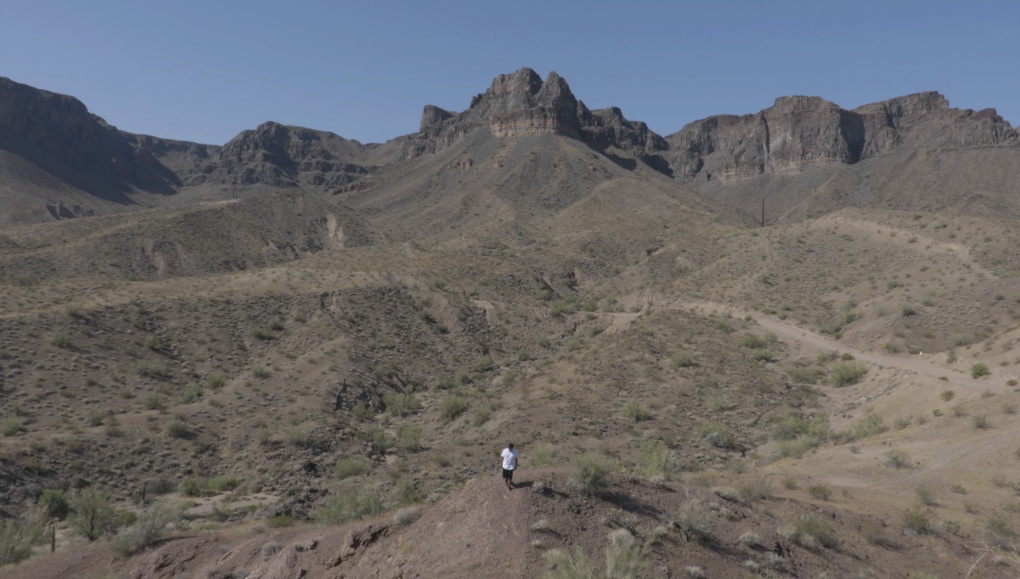
Etienne de France, Looking for the Perfect Landscape, 2017, video, color, sound, 45 min
Every evening and every morning, he reflects on the transformation of the land. It’s a very contemplative piece of work, where we simply watch him interacting with these people and places. In the end, I think we can see how he is transformed by the whole process. So maybe the fiction is more about my own journey through this land and this is why I brought in the fiction as an external element; but Jamahke is not a representation of me, either.
The question I raise is about the representation of these lands and the struggles and fights around them. For Jamahke, it’s a journey through his own land, and an occasion to meet with the elders and bond with people he does not often talk to.
AM: Coming back to Los Angeles, you got ready for the shoot. What kind of documents did you prepare—was it a full script? Did you write all the dialogue?
EDF: I had a structure in my mind. I wrote a ten-page synopsis with a seven-page story. It was more like an aesthetic treatment than a traditional synopsis. I sent it to David, who was very receptive to it. So I didn’t work with a detailed script but something more like a grid, with a lot of visual and sound direction for the director of photography and the sound engineer. It included many explanations of why I was doing this project, really highlighting the fact that it was complicated for me to speak about this idea of representation. The document explained how I wanted to approach these questions artistically and visually. I also created a story for each of the four days, introducing some kind of written dialogue.
The idea of going on a journey was always central to the story. It also echoed the bird songs. They are creation songs, sometimes sung during funerary rituals—cremation rites. People accompany the dead for three nights and four days, singing these songs. The songs describe the trip the soul takes through the Mohave aboriginal lands before resting. They take the soul to many locations in the land that were important for the migration routes and coincide with the Mohaves’ travel through the desert.
For the script, I tried to respect the reason for those four days and three nights. Without using their exact narrative structure, I tried to infuse influences from the bird songs and myths I had access to. It helped me build a structure, a backbone for the story. I used this rhythm of four days and three nights with an emphasis on sunsets and sunrises. Little ritual things that happen in the story were inspired by myths. The people I met somehow chose the places I went for the film; we went to places they wanted to talk to us about.
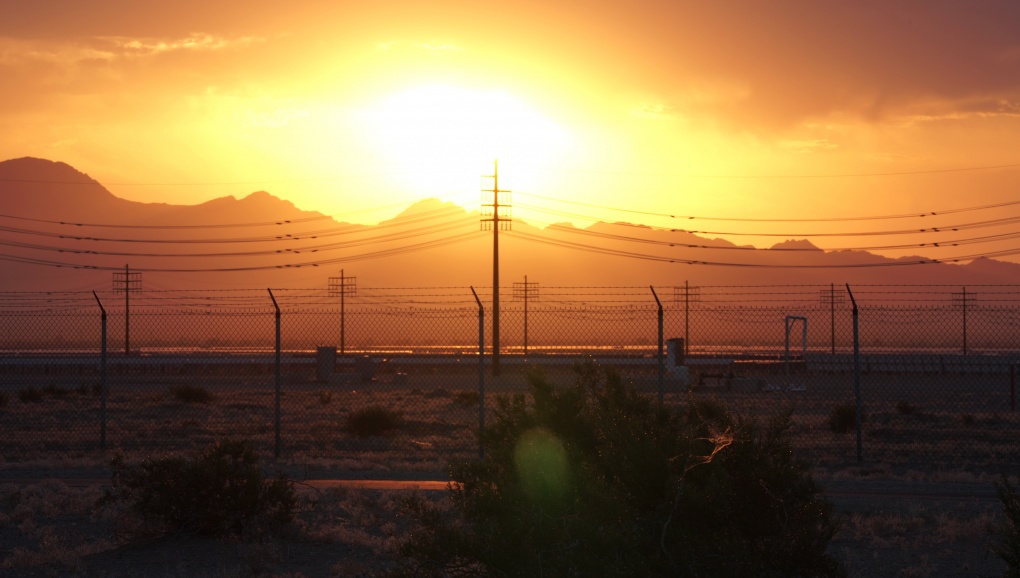
Etienne de France, Looking for the Perfect Landscape, 2017, video, color, sound, 45 min
AM: All of your “actors” are playing their own parts. Where does your territory as a video director start and where does it end? Did they completely go off on the discussion, based on the topic you give them? How do you deal with the fact that you’re actually directing real people?
EDF: The only direction I gave was to choose the shooting places based on what they had spoken to me about and what they wanted to show me during my scouting trip. I then chose which places we would go to for the actual shooting and they would speak about them on camera. It was very natural for them to do so. I would say that each location has a specific importance for them. Some are linked to ongoing struggles and fights.
When I felt a resistance to go to or talk about a specific place, I respected it. It is very important for me not to repeat the intrusion on an artistic level. I didn’t impose much on them, except for a lot of walking for Jamahke.
It was quite an organic process and I feel that’s the way it should be when you work in collaboration with other people. Sometimes I had to rewrite something the night before the shoot because something happened during the day and I felt like I had to make a change. Sometimes I also asked Jamahke or David if there were specific places they wanted to go. Jamahke once brought us to a place where he really wanted to sing. It was a very beautiful place and we shot him there.
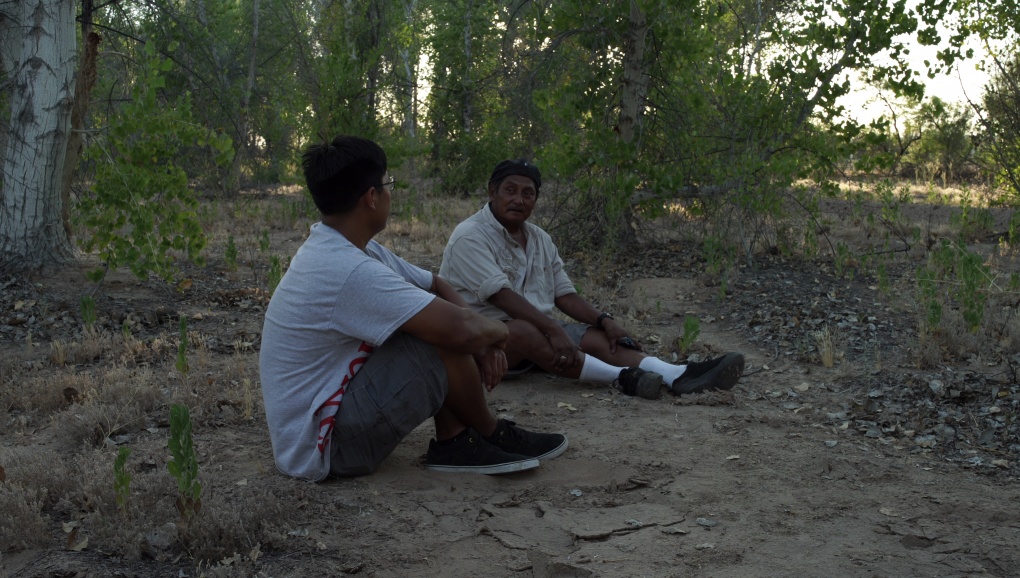
Etienne de France, Looking for the Perfect Landscape, 2017, video, color, sound, 45 min
AM: You mentioned that it was a very organic collaboration with the people. How does this project also become an exchange?
EDF: I think people were very curious about the project because the reservation is small town and there are only two thousand people living there. Information travels quickly and people knew why I was there. Jamahke also spoke to his friends and family, and they spread the word as well.
I think we can also ask the question of the interest to the tribe. Part of the deal was of course for them to receive a copy of the video, but what else do they gain by opening their doors and being so generous? It becomes part of a broader question of how art can cooperate with other disciplines.
I think the project, beyond its format as an artwork—as a film, as an installation, or as a piece that can be shown on the Internet or different platforms—will be a visual and poetic object that also deals with the environmental crisis we are facing. It could work as an educational tool about the domination and oppression of the reservation system. I always ask myself about the meaning of a project like this and how an artwork can have a tangible impact, for educational, political, or other purposes. On that note, I’m very inspired by Maria Teresa Alvez, who is a brilliant artist, and by Amar Kanwar, who did a beautiful project about The Sovereign Forest in India. They are both discussed in TJ Demos’s book Decolonizing Nature, which is a very important reference for me.
In the case of this project, the environmental discussion is here and present, and it will hopefully raise awareness in different areas and can open a dialogue. I would really like for David to be present for some screening of the project and to speak about these issues.
Beyond that, the work is an important archive for the tribe. We shot so many interviews with the elders that will not fit into the final work, due to time constraints, but we will edit all the interviews and give them to the tribe library for their archive. I would also be interested to continue my collaboration with Jamahke on another presentation of the work. He writes poetry and draws, so we could think about some kind of collaboration together.

Beyond the pure presentation of the project in a film festival or art context, it is important to me to present the work at the Colorado River Indian Tribe and see how this project could be shown in the reality of the reservation.
AM: And how it can become the beginning of a conversation?
EDF: Yes, or the continuation.
AM: The origin of this project lays on the question of the representation of the desert as a symbolic and political place, what ideas are conveyed by this landscape and how it builds a certain representation. Where do you stand on these questions now that you’ve actually produced these images?
EDF: I’m not interested in the desert as a nostalgic place. I’m not interested in the fascination with these old mining and ghost towns. I think I’m still processing it a little bit. Artistically, with my own practice of representation of the landscape, I consider the desert landscape today as a place of struggle, a place of pressure—of capitalistic pressure on the land—and also a place of spirituality.
I’m representing this idea through the lens of the Mohave people but, in a larger sense, I have always been interested in how the spiritual imaginary is attached to the land. I could have done a project just about the river, or just about the fish. My choice was to represent a space of conflict, a desecrated land that is filled with imagination.
People think that “imagination” means something that is not real, something they can find in a movie theater. That’s a problem. Facing the land, they impose another narrative on it; that’s okay in some cases, but they don’t realize that imagination and spirituality are as tangible as the land itself for many people. Imagination is real, and the land is real, and the conflicts taking place on that land are real. This reality actually feeds the fictional narrative, which would hopefully help define another kind of representation.